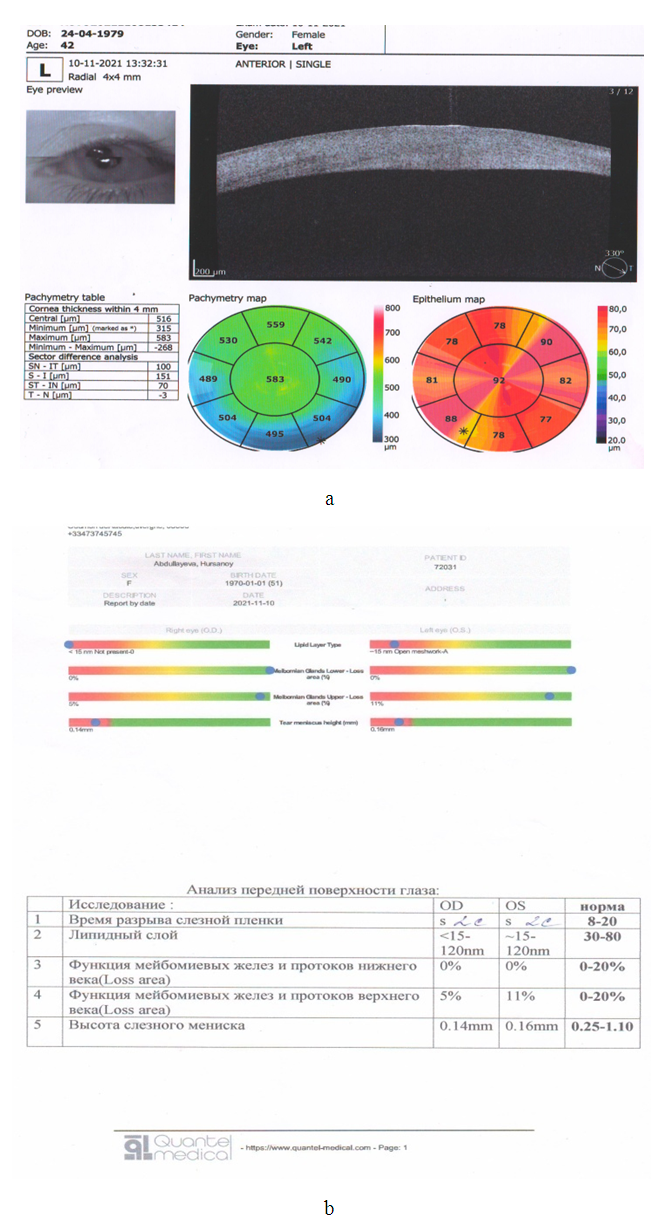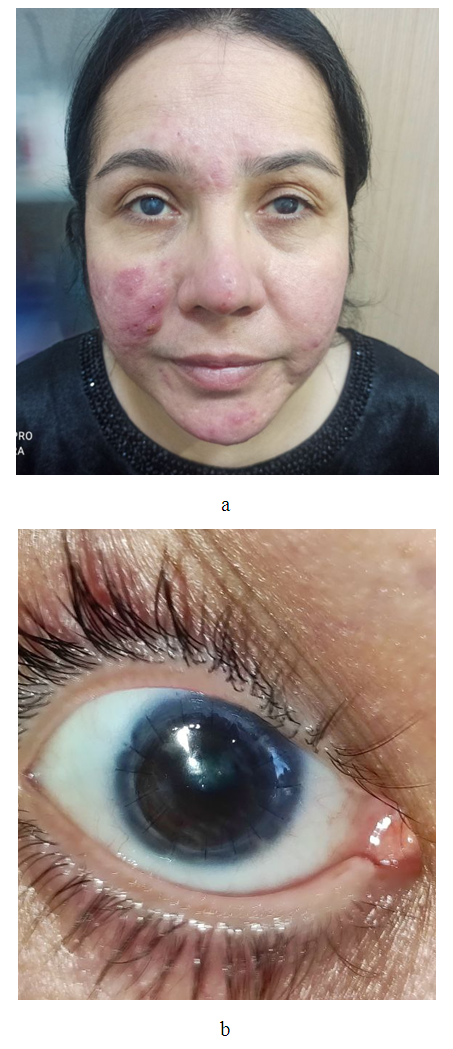-
Paper Information
- Next Paper
- Previous Paper
- Paper Submission
-
Journal Information
- About This Journal
- Editorial Board
- Current Issue
- Archive
- Author Guidelines
- Contact Us
American Journal of Medicine and Medical Sciences
p-ISSN: 2165-901X e-ISSN: 2165-9036
2023; 13(11): 1663-1665
doi:10.5923/j.ajmms.20231311.15
Received: Oct. 16, 2023; Accepted: Nov. 6, 2023; Published: Nov. 8, 2023

End-to-End Cornea Transplant to an Eye with a Corneal Ulcer Complicated by Rosacea
Abdullaev Sherzod Rakhmatovich
Center for the Development of Professional Qualification of Medical Workers, Ministry of Health of the Republic of Uzbekistan, Tashkent, Uzbekistan
Correspondence to: Abdullaev Sherzod Rakhmatovich, Center for the Development of Professional Qualification of Medical Workers, Ministry of Health of the Republic of Uzbekistan, Tashkent, Uzbekistan.
Copyright © 2023 The Author(s). Published by Scientific & Academic Publishing.
This work is licensed under the Creative Commons Attribution International License (CC BY).
http://creativecommons.org/licenses/by/4.0/

Ophthalmic rosacea has a variety of clinical manifestations. One of the most common forms of ophthalmic rosacea is damage to the cornea in the form of rosacea keratitis and rosacea corneal ulcers (up to 30% of all cases). Corneal damage is usually bilateral, accompanied by a significant decrease in visual function, while the severity of eye damage often does not correlate with the severity of skin manifestations of rosacea.
Keywords: Rosacea, Ophthalmic rosacea, Corneal ulcer, Treatment, End-to-end corneal transplant
Cite this paper: Abdullaev Sherzod Rakhmatovich, End-to-End Cornea Transplant to an Eye with a Corneal Ulcer Complicated by Rosacea, American Journal of Medicine and Medical Sciences, Vol. 13 No. 11, 2023, pp. 1663-1665. doi: 10.5923/j.ajmms.20231311.15.
1. Introduction
- Rosacea is quite common around the world: in particular, in the UK, there are 165 rosacea patients per 100,000 people [4]. In the RISE study (Rosacea International Study on Epidemiology) in 2015. revised data on Germany and Russia were received; the prevalence of rosacea in Germany was 12.3%, in Russia - 5%. In Russia, the analysis of demographic characteristics revealed the predominance of women, 75% of whom were in premenopause, the average age was 40 years, the distribution by phototypes showed that the majority of patients were with phototypes 2 and 3 [2,3]. In a screening study conducted in Estonia, out of 348 randomly selected people, at least one sign of rosacea was detected in 22% of cases. The most common were erythema and telangiectasia. However, the epidemiological data appear to be incomplete: it is likely that many patients either do not see a doctor or are "treated" by a beautician.Ophthalmic rosacea is a chronic inflammatory skin disease in which the skin of the periorbital region is observed, blepharitis and conjunctivitis develop. Without proper treatment, ophthalmic rosacea can lead not only to the development of severe cosmetic defects, but also to visual impairment. In connection with this early diagnosis and adequate treatment of this disease cannot be overestimated [1].Rosacea is an etiological inflammatory inflammation accompanied by chronic manifestations of polymyex. It is primarily a dermatological disease, but there are also ocular manifestations involving the eyelids, cornea, and conjunctiva. The leading role in the pathological process is played by a violation of the regulatory functions of the vascular, immune and nervous systems. At the same time, an increased level of metalloproteinase and vascular endothelial growth (VEGF) is detected. Treatment depends on the severity of the disease and can range from eyelid hygiene and the use of tear substitutes for dry eye syndrome to the use of antibiotics and anti-inflammatory drugs for moderate disease and surgical treatment in cases of detection or advanced cases of the disease. High-risk follow-up over time has shown that the use of mushroom keratoplasty with a surgical incision profile can achieve high results, as well as reduce postoperative probability and reduce the risk of postoperative complications. The use of anti-VEGF therapy can significantly reduce the risk of tissue incompatibility reactions by suppressing neovascularization characteristic of rosacea keratitis [2,5].Goal of the work. To study the clinical course of a patient with a corneal ulcer complicated by rosacea who underwent a penetrating corneal transplant.
2. Materials and Methods
- Patient A.Kh. was under our supervision. 42 years old, diagnosed with OU – ophthalmic rosacea (corneal cataract, category 3). The ophthalmological examination included visometry (OD/OS=0.02/0.03=n/k), pneumotonometry OD/OS=16/17mmHg), biomicroscopy, anterior and posterior OST to determine the depth and area of corneal lesions (Fig. 1a.), ultrasound of the eyeball (B-scan), pachymetry. To identify demodectic mites, epilated specimens of eyelashes and scrapings from the patient’s facial skin were examined. The degree of impairment of tear production was determined by Schirmer and Norn tests. The function of the meibomian glands was determined using the Lacry Diag device (Fig. 1b).
 | Figure 1. a. Anterior OST of the left eye; b. Analysis of the result of the device Lacry Diag |
3. Results and Discussion
- When contacting us, the patient complained of burning and stinging in the eyes, redness, lacrimation and photophobia, a feeling of a foreign body and sand in the eyes, and decreased vision. When examining the patient, we paid attention to the skin of the face: slight erythema of the cheeks, bright red papulopustular rashes, changes in the skin of certain parts of the face (Fig. 2a). In the standard treatment of ophthalmic sacea, drugs of local and systemic action are used. Systemic therapy included Metronidazole, Wolfuran, doxycycline, angioprotectors, antihistamines, and vitamins. Local treatment: Actipol, Ophthalmoferon and Okoferon in instillations, T-life in the form of intramuscular and intravenous injections.With the permission of the dermatovenerologist and gastroenterologist, we performed penetrating keratoplasty of the right eye (Fig. 2b).
 | Figure 2. a - patient A.R., 42 years old. OU is a corneal cataract after keratitis with ulceration; b - after 2 months after surgery: OD-end-to-end corneal transplant |
 Abstract
Abstract Reference
Reference Full-Text PDF
Full-Text PDF Full-text HTML
Full-text HTML